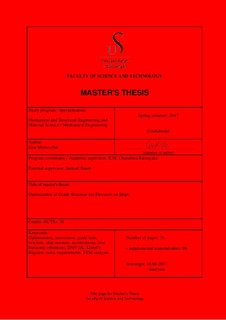| dc.description.abstract | The existing design of marine and offshore elevators are mainly based on the expertise out of land-based elevators, with higher safety factors and all existing requirements being fulfilled. In the design of the guide structure, it is usually selected large guide rail dimensions and customized brackets of thick steel plates to account for the unknown load cases. This leads to increased weight of the structure, as well as more cost of material and installation. The cost is always important for the customer, but the weight of the components has also been a major focus the recent years. Less weight would allow more passengers and goods aboard the ship, which is especially important for cruise ships where each passenger results in more income. Together with the cost and the functionality of the product, it is therefore an attractive feature when selecting the elevator supplier. Research on the resulting forces caused by the ship motions has therefore been done, to increase the knowledge of guide structures for elevators operating in the maritime and offshore environment. A thorough literature study on current rules and requirements for elevators on ships, with special attention to the guide structure, has been carried out. Four different methods for calculating the load case acting on the structure are developed from this. The first method is based on the theory of free harmonic vibration, while the other three are based on rules, requirements and equations defined by DNV GL and Lloyd’s Register. Furthermore, a mapping of load cases has been done to evaluate the forces acting on the guide structure caused by the different ship types. This was solved by dividing the ships into three different classes based on similarities in type, dimensions and resulting motions. The optimization of the brackets involves two different solutions; a standard bracket developed for land-based elevators and a customized bracket developed for offshore elevators. Offshore elevator trunks are built with bulkhead stiffeners on the inside or outside, depending on the ship designers. The stiffeners are in most cases placed inside the trunk, because it is more usual to use this space for insulation instead of placing it in the adjacent corridor. The standard bracket is easier to install, and would be the preferable solution given that the trunk is built with the stiffeners on the outside. Both solutions were evaluated with the use of a structural FEM analysis. This was done to verify if the standard brackets are applicable for offshore applications, and to optimize the customized brackets in terms of weight and installation cost. The calculation methods are tested on different ship types, and the result shows that it is possible to reduce the guide rail dimensions. Most of the evaluated ships are installed with T127 guide rails for their elevator car. The calculation methods do however show that T90 guide rails could be used instead, since this is the recurring dimension from all the ship examples. Furthermore, it is recommended to use the standard bracket given that its applicable for the trunk layout. The FEM analysis verified that the solution could be used for offshore elevators up to 4000 kg. It is also suggested to reduce the plate thickness and width of the customized bracket, since it still would be within acceptable safety factors. The reduction of guide rail dimensions and usage of the standard bracket could save up to 40 % in cost of installation, based on the examples given in the paper. | nb_NO |

